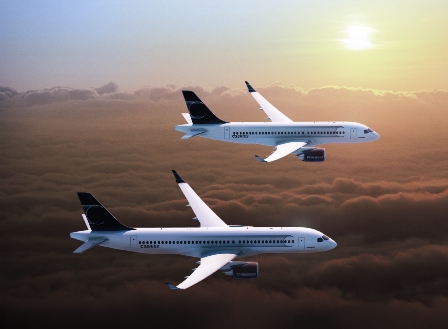The 100- to 149-seat aircraft market could become more crowded following last week's revelation that Embraer is considering developing an aircraft directly pitched at the upper end of the segment.
Although the big two airframers both offer jetliners in the sector - the Boeing 737-700 and Airbus A319 respectively - they are shrunk versions of their bestsellers.
Bombardier is the only manufacturer to be working on an optimised aircraft for the segment with its two CSeries models - the CS100 and CS300 - due to enter service in the second half of 2013.
Powered by the Pratt & Whitney PW1500G engine, the CSeries promises to be one of the most advanced and fuel-efficient aircraft in the sector. Bombardier claims a potential 20% reduction in fuel consumption against its competitors.
However, sales have so far been thin on the ground, with only 90 firm orders. Lufthansa is the highest-profile name to place an order so far, for 30 of the smaller CS100s.
Bombardier optimistically predicted a 50% share of the market, but as a research note from Canadian investment firm Cormark Securities, published in November last year, noted: "[]our belief is Airbus and Boeing will fight back hard with sub-optimal re-engined aircraft or new clean sheet designs in [around] 10 years or so."
 |
|---|
© Bombardier |
And fight back they have. Airbus's recent decision to advance the development of its re-engined A319neo, to 2016 from 2017, seems to be a direct move against the CSeries, particularly the CS300. The P&W PW1100 powerplant will be the lead engine for the development of the Neo.
It is a strategy that may already be bearing fruit: Republic Airways Holdings, parent company of CSeries customer Frontier Airlines, has just put down an $8m place holder deposit with Airbus for A320neo-family aircraft. Although there are no further details of the deposit, it does raise questions over the robustness of its order for 40 CSeries aircraft.
Meanwhile, Boeing is due to clarify its position on the 737 replacement next month, potentially generating another competitor. The outcome of Boeing's deliberations will then also determine Embraer's next move.
Speaking on a 3 May analysts call, Embraer chief executive Frederico Curado said that if Boeing's new offering was centred in the 185-seat range, it would look to the 145-seat market, either with a re-engined, re-winged and stretched version of its E-195 jet, currently pegged at 122 seats, or an all-new five-abreast aircraft.
Embraer's volumes are currently steady. It delivered 101 commercial aircraft last year, the vast majority of which were E-190s or E-195s, and expects to hand over a similar number in 2011.
Richard Aboulafia, aerospace analyst at Teal Group, says that the imperative for Embraer to update its range is much less than for some of the other airframers. Nonetheless, he said that a "relatively quick derivative of the E-195" would hurt "the CSeries at the bottom of the range".
He said: "With a new engine and better range you [would do] a lot of damage to the CS100."
Any larger version would also have the potential to threaten the CS300, he said, which is already under pressure from the Airbus A319neo.
Aboulafia feels that a refined version of the E-195 is the more likely route, given the other development priorities for Embraer (the KC-390 tanker/transport and the Legacy 450 and 500 business jets).
However analyst Michael Willemse, of Canadian firm CIBC Equity Research, said that it is too early to judge the success or failure of the CSeries. He said although the lack of orders is "concerning", it would not be until this point next year that a proper judgement can be made. He said: "Most airlines want another supplier and like the fact that the CSeries is built specifically for that market.
"Over the next year we will have a better indication of how real that interest [from airlines] is. Perhaps they are more interested in kicking tyres than making real orders."
One indicator of the CSeries's progress, he said, is whether it or the Airbus A319neo secures the next order.
CIBC has forecast that Bombardier will take a 35% share of the segment - delivering around 100 aircraft per year - he said, with any competition from Embraer unlikely until post-2020.
Aboulafia is more pessimistic, however. He believes the CSeries will only sell around 50 each year. Despite its high level of technological advancement, it runs the risk of becoming the Betamax of the aircraft industry, he said. "It's kind of a pity because if it wasn't for [Bombardier] we wouldn't have seen the introduction of these new [more efficient] engines.
"In a few years we'll either see it as their contribution or their noble sacrifice," he said.
Bombardier said: “The CSeries has already captured 50% of the market in the 100- to 149-seat segment – it’s a game changer with a strong future. Since you can’t have a game-changing aircraft without a game-changing engine, it’s particularly gratifying that we will be the first to market with Pratt & Whitney’s geared turbofan engine – now endorsed by several competitors in other new or re-engined aircraft programmes.”
The Canadian airframer has no concerns with the status of Republic’s order, it said.
Source: Flight International























